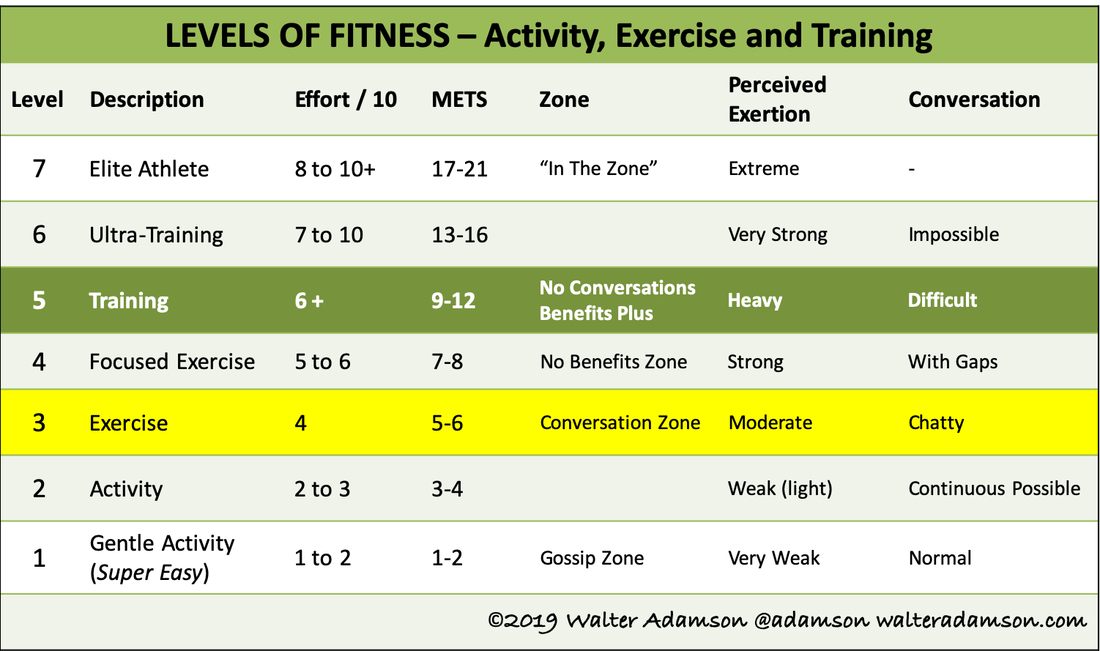|
SEARCH My Blog (Opens in new tab)
The truth about calorie countersIt's human nature that when we are focused on a goal, such as losing weight, that we underestimate the effort and overestimate the potential outcomes. Case in point - calories. We have ready access to calorie counters - on our personal devices and on the machinery at gym. But are they telling you the truth? Unfortunately, the answer is "mostly not". These devices are most likely to be overestimating your calorie burn. After all, who wants to sell a gadget that delivers bad news? Even worse, they make no allowance for your body's ability to exercise more efficiently as you train. That's really bad news, as you could be burning far fewer calories than you imagined. Here's a better way to estimate your calories, based on what you know but what your devices do not know - your exercise exertion. I don't pay much attention to my calorie burn from exercise. I know that it is a substantial quantity compared to my weekly food intake. And I know how to adjust food or exercise to maintain my desired body composition. What I do pay attention to is the world of people exercising around me. My most common observation is that their expectations don't seem to align with their commitment. Unfortunately, that leads to disillusionment, which disappoints me. It disappoints me because it is often an outcome of how they set themselves up for failure by having misguided expectations. If they reset their expectations then they would persist in their efforts to become more healthy and fit. When it comes to how many calories each of us individually burn during exercise, the problem is a lack of knowledge. With the knowledge, we can reset our expectations. There is an established methodology which you can use to easily estimate your calorie burn - it's the MET concept. METS directly relate to caloriesA MET is One Metabolic Equivalent of Task - defined by the amount of oxygen used when sitting at rest - when sitting quietly in a chair. When we are using more energy, we have to consume more oxygen - that's axiomatic. The MET concept represents a simple, practical, and easily understood method for expressing the energy cost of physical activities as a multiple of the resting metabolic rate. If you are doing activities at a level of 2 METS then you are burning twice the energy of sitting quietly in a chair. If 3 METS then 3 times the energy of sitting. For me, I know that when I run I burn 2.4 times the energy per minute I use when walking. My walking would be at 5 to 6 METS, and therefore my running is at 12 to 14.4 METS. Here's the kicker: METS are directly related to calories (since calories represent energy). One MET can be considered 1 kcal/kg/hour. Since sitting quietly is one MET, a 70 kg person would burn 70 calories (kcal) if they sat quietly for an hour. Here's an online METS-to-calories calculator from Cornell University Ergonomics Unit (non-metric, unfortunately). Most of us overestimate how much energy we burn during exercise (and overestimate the size of the cake we can eat afterwards). To know METS we use our perceived level of exertionWhen official health guidelines say things like "moderate exercise includes taking a walk" that's just code for "if we told you the truth you wouldn't do it". The truth is that walking the dog and chatting with your friend is fantastic mobility but barely more than washing the dishes in terms of metabolic effort. You can check this in my METS Exercise Chart below. Take a Spin class at the gym, for example, or for that matter the regular morning cycling group. In both instances, I see lots of people spending 40 minutes to an hour exercising, and enjoying a bit of a chat. There is comfort in the "estimated calories" which most Spin bikes display. However, your comfort may be misplaced.
The same types of issues apply to the running machines and stair-climbing machines - all the machines in the aerobics room at the gym. Utilising the LEVELS OF EXERTION technique we can convert effort to METS and then METS to calories. The best proxy for exertion is Borg's perceived levels of exertion and the relationship between those levels and your ability to hold a conversation. Let's check it out. Most of the spin class is having a bit of chat with their neighbours. The instructor is adding a bit of theatre by yelling for more. There's little sweat. The level of effort is 3 and the METS 5 to 6, according the METS chart. On the road, on the regular coffee cycle run, there's a lot of chat to be heard from among the peloton. That indicates a level of effort of 3 or 4, and the METS from 5 to 8. 1 MET is equivalent to 1 calorie/kg/hour. A 70kg person, in one hour, utilizes 70 calories. In the above scenarios, this person would burn:
They are actually good results, and despite a small sports drink wiping 100 calories off your effort you have still a residual gain. How to use METS to stick with your exercise programHow do you use METS? When you are moving / exercising check-in with your breathing effort - as on the table above. For example, if you are still quite chatty then your METS level is 5 to 6, if you've been struggling to talk then it is 9-12. Multiply your MET level BY your weight in kilograms BY the time in HOURS (or fraction thereof). This gives you the number of calories you burnt. Now you are all set to know the real calories, and to adjust your expectations of weight loss, for example, using this knowledge. If you are burning - at Spin - 315 calories, adding back 100 calories with a sports drink, and then 300 with two Starbucks café lattes later in the day, then you are only shedding 15 calories for your hours work at the gym. Keeping that in mind, adjust your expectations. Some typical activities and their METS are (ref: Metabolic Equivalents in Exercise Testing, Exercise Prescription, and Evaluation of Functional Capacity M.JETTE, K.SIDNEY, G.BLUMCHEN, 1990):
By taking note of your breathing level, and applying the formula for METS, and you have a practical and realistic way to estimate your calorie consumption. Use this to set your expectations, to help you stick with your exercise program for longer. Consistency wins, so stick with it. Follow me on Quora for more health and fitness tips.
If you enjoyed this article >> Follow me Leave a comment >> Share it >> Stay healthy If you have any questions email me and I will get back to you. Latest: get your free customised fitness plan designed uniquely for you.
|
ChoicesSince I was diagnosed at 50 with Type 2 diabetes I've been learning how to do bone-building fitness training which lowers my age. You can too. It's your choice. Walter Categories
All
Archives
May 2023
|


 RSS Feed
RSS Feed 


